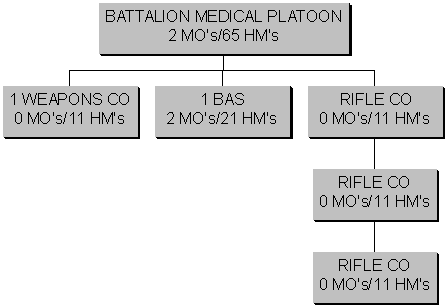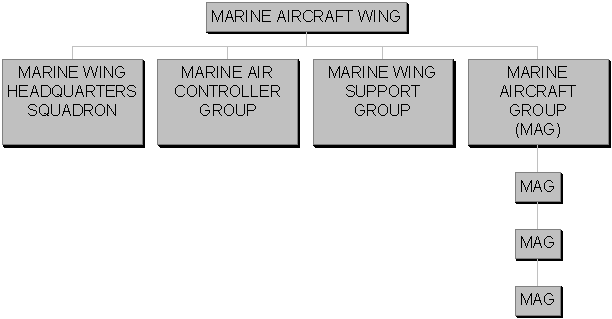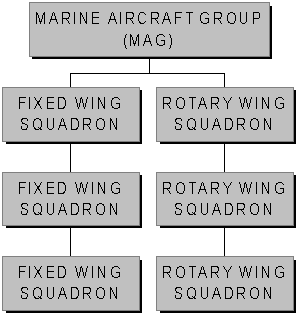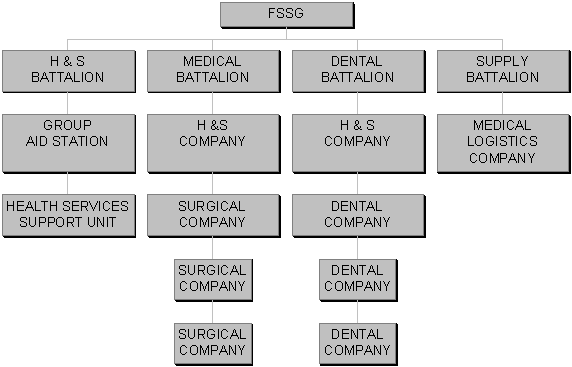|
Medical Education Division |
Operational Medicine 2001
Field Medical Service School
Student Handbook



|
HEALTH SERVICES SUPPORT WITHIN THE MARINE CORPS
OPERATING FORCES FMST
0301 17
DEC 99
TERMINAL
LEARNING OBJECTIVE: 1.
Given the requirement, identify the Health Services Support elements within the
Marine Corps Operating Forces. (FMST.03.01) ENABLING
LEARNING OBJECTIVES: 1.
Without the aid of reference materials and given a list, identify the Health
Services Support of the Ground Combat
Element, per the student handbook. (FMST.03.01a) 2.
Without the aid of reference materials and given a list, identify the Health
Services Support of the Air Combat Element, per the student handbook.
(FMST.03.01b) 3.
Without the aid of reference materials and given a list, identify the Health
Services Support of the Force Service Support Group, per the student handbook. (FMST.03.01.c) OUTLINE: A. MISSION OF THE MEDICAL DEPARTMENT 1.
The primary mission of medical and dental units supporting the Marine Corps
Operating Forces is the conservation of the combat power of the troops. This is accomplished through measures designed to safeguard
the health of the Force through early effective care of the sick and injured,
prompt and appropriate evacuation of casualties, and through diligent
health/risk surveillance and preventive medicine strategies. 2.
The Marine Corps Operating Forces are organized into “Marine Air Ground Task
Forces” (MAGTF), for conducting combat operations.
Each MAGTF, regardless of size, is a combination of forces made up of
four elements. CE
- Command Element, deployed for command and control of the MAGTF. Personnel may
be sourced from any of the supporting units. GCE
- Ground Combat Element, comprised of Marine Division personnel. ACE
- Aviation Combat Element, from Marine Wing personnel. CSSE
- Combat Service Support Element, drawn from Force Service Support Group
personnel. 3.
There are health service support personnel and equipment organic to each of
these MAGTF components. Each health
service support element is sized and equipped appropriately to support the
personnel and mission requirements, when assigned to a MAGTF. B. HEALTH SERVICES SUPPORT - GROUND COMBAT ELEMENT (GCE) 1.
The Ground Combat Element of a MAGTF is comprised of Marine Division units sized
to the mission. a.
MEF - Marine Expeditionary Force: A Marine Division is the Ground Combat Element (GCE) for a MEF. b.
MEB - Marine Expeditionary Brigade: A Marine Regiment is the Ground Combat
Element (GCE) for a MEB. c.
MEU - Marine Expeditionary Unit: A Marine Battalion Landing Team is the Ground
Combat Element (GCE) for a
MEU. 2.
The Division Command Element Medical Staff consists of the Division Surgeon, a
Psychiatrist, a Medical
Administrative Officer, an Environmental Health Officer, and enlisted staff to
provide administrative support, training, and
Senior Enlisted Leadership to all subordinate medical personnel within the
Division. a.
The Division Surgeon functions as a special staff officer, advising the Division
Commander on all matters relating to the health of the Division, including the
health service support requirements and allocation of medical resources. 3.
The Regimental Command Element Medical Staff consists of the Regimental Surgeon,
and a number of Hospital Corpsmen.
This section makes up the Regimental Aid Station and provides medical
support to Regimental Headquarters personnel. a.
The Regimental Surgeon is a special staff officer who reports to and advises the
Regimental Commander in matters concerning health services of the Regiment. 4.
The Medical Staff of an Infantry Battalion consists of two Medical Officers and
sixty-five Hospital Corpsmen. They
make up the Battalion Medical Platoon. a.
One of the two Medical Officers in an Infantry Battalion is designated as the
Battalion Surgeon. The Battalion
Surgeon is a special staff officer who advises the Battalion Commander on
matters pertaining to the health of the Battalion.
The duties of the Battalion Surgeon include supervising patient
treatment, planning, organizing, training the Battalion Medical Staff, and
performing such other duties as the Battalion Commander may direct. b.
The other Medical Officer in an Infantry Battalion is designated as the
Assistant Battalion Surgeon. The
primary job of the Assistant Battalion Surgeon is to direct, manage, and
supervise the operation of the Battalion Aid Station (BAS), and to perform such
additional duties as may be assigned by the Battalion Surgeon. c.
Twenty-one of the sixty-five Hospital Corpsmen in an Infantry Battalion are
assigned to the Battalion Aid Station (BAS), under the supervision of the
Assistant Battalion Surgeon. This
group of twenty-one Hospital Corpsmen is called the Aid Station Group.
The Aid Station Group is capable of splitting into two sections to
operate two separate Battalion Aid Stations when necessary. The Battalion Surgeon will normally head the second aid
station. d.
The remaining forty-four Hospital Corpsmen assigned to the Battalion Medical
Platoon are divided into four groups of eleven Corpsmen called Company Medical
Teams. One Medical Team is assigned
to the Weapons Company and one is assigned to each of the three Rifle Companies
of an Infantry Battalion. e.
The Senior Hospital Corpsman from each Medical Team is designated as the Company
Corpsman and is assigned to the Company Headquarters.
The remaining corpsmen assigned to a company are designated Platoon
Corpsmen. 5.
A Litter Bearer Group also operates under the supervision of the Battalion
Surgeon. Litter Bearers are not
part of the Battalion Medical Section, they are Marine Corps personnel assigned
by the Battalion or Regimental Commander. Litter
bearers should be designated well in advance of operations so that they may be
trained in the proper techniques of casualty handling. MEDICAL
PERSONNEL ASSIGNED TO AN INFANTRY BATTALION
Figure
1 - Infantry Battalion Medical Personnel By Element C. HEALTH SERVICE SUPPORT - AVIATION COMBAT ELEMENT (ACE) 1.
The Aviation Combat Element of a MAGTF is comprised of Marine Aircraft Wing
units (Fixed Wing and/or Rotary Wing) to support the appropriate mission. a.
MEF - Marine Expeditionary Force: A Marine Aircraft Wing (MAW) is the Aviation
Combat Element (ACE) for a MEF. b.
MEB - Marine Expeditionary Brigade: A Marine Aircraft Group (MAG) is the
Aviation Combat Element (ACE) for a MEB. c.
MEU - Marine Expeditionary Unit: A Marine Aircraft Squadron/or composite
squadron is the Aviation Combat Element (ACE) for a MEU. 2.
The Wing Command Element Medical Staff consists of the Wing Medical Officer or
Wing Surgeon, a Medical Administrative Officer, an Environmental Health Officer,
an Industrial Hygienist and enlisted personnel as assigned. a.
The Wing Medical Officer or Wing Surgeon functions as a special staff officer,
advising the Wing Commander on all matters relating to the health of the Wing;
including the development of medical policies for the Wing, training of medical
and non-medical personnel, health service support requirements, and allocation
of medical resources. b.
The remainder of the Wing Surgeon's Staff is responsible for medical planning,
logistics, coordination of administrative functions, maintenance of records, and
personnel administration. 3.
A Group Medical Section for each Marine Air Group (MAG), consists of a Medical
Officer and Hospital Corpsmen. The
MAG Medical Officer carries out the Wing Surgeon's policies, performs his duties
in support of the MAG personnel and is a special advisor to the Marine Air Group
Commander. a.
The Marine Wing Support Group includes four Marine Wing Support Squadrons (MWSS),
with organic (from the unit), medical assets consisting of medical officers,
hospital corpsmen, and the equipment and supplies to establish a Squadron Aid
Station. The MWSS Aid Station is
capable of providing routine sick call, aviation medicine, preventive medicine,
laboratory, radiology and pharmacy services. 4.
Each flying squadron within a Marine Aircraft Group has a medical section
consisting of a Flight Surgeon and a number of Hospital Corpsmen depending on
squadron type. The Squadron Medical
Section conducts routine sick call and other aviation medical functions. 5.
In order to centralize organization and support, squadron medical personnel
normally work in conjunction with the Marine Wing Support Squadron (MWSS) Aid
Station. MEDICAL
PERSONNEL ASSIGNED TO A MARINE AIRCRAFT WING (MAW)
Figure 2 - Medical Elements of a Marine Aircraft Wing
D.
HEALTH SERVICES SUPPORT - COMBAT
SERVICE SUPPORT ELEMENT (CSSE) 1.
The Combat Service Support Element of a MAGTF is developed around units from a
Force Service Support Group (FSSG). a.
MEF - Marine Expeditionary Force: A Force Service Support Group (FSSG) is the
Combat Service Support Element (CSSE) for a MEF. b.
MEB - Marine Expeditionary Brigade: A Brigade Service Support Group (BSSG) is
the Combat Service Support Element (CSSE) for a MEB. c.
MEU - Marine Expeditionary Unit: A MEU Service Support Group (MSSG) is the
Combat Service Support Element (CSSE) for a MEU. 2.
The Force Service Support Group (FSSG) Command Element Medical Staff consists of
the Group Surgeon and a number of personnel making up the Group Aid Station
(GAS) and the Health Service Support Unit (HSSU). a.
The Group Surgeon functions as a special staff officer advising the FSSG
Commander on all matters relating to the health of the FSSG.
The Group Surgeon also supervises the operations of the Group Aid
Station. b.
The Group Aid Station (GAS) provides internal health service support to the FSSG. c.
The Health Service Support Unit (HSSU) coordinates the requirements for health
service support and Class VIII supplies required above the organic capabilities
of the Ground Combat Element (GCE) and the Aviation Combat Element (ACE). 3.
The Medical Battalion of the Force Service Support Group is the primary source
of health service support above the Battalion Aid Station which is provided by
and organic to the Ground Combat Element. It
provides initial resuscitative care and temporary holding of casualties.
The Medical Battalion is made up of a Headquarters and Service (H&S)
Company and three Surgical Companies. a.
The Headquarters and Service Company includes an administration and personnel
section, an intelligence and operations section, a logistics section, a
communications section, a chaplain's section, a preventive medicine section, and
eight Shock and Trauma Platoons (STP). 1.
The Shock and Trauma Platoon provides comprehensive, mobile health service
support to a Ground Combat Element (GCE) Battalion Aid Station (BAS).
Each platoon consists of a Stabilization Section and a Collecting and
Evacuation Section. a.
The Stabilization Section of an STP consists of two Medical Officers, a
Physician Assistant, and 7 HM 8404's. The
Stabilization Section is highly mobile and is capable of providing advanced
trauma life support. b.
The Collecting and Evacuation Section of an STP consists of a Nurse Corps
officer, 1 IDC HM, 3 HM 8404's and 10 Marine Corps motor vehicle and radio
operators. The mission of the
Collecting and Evacuation Section is to collect and transfer casualties as well
as provide advanced trauma life support. b.
The Surgical Companies provide general health service support including medical
and surgical care and temporary holding of casualties.
Each Surgical Company consists of a Headquarters Platoon, a
Triage/Evacuation Platoon, a Surgical Platoon, Holding Platoon, Combat Stress
Platoon, and Ancillary Service Platoon. 1.
The Surgical Platoon consists of three Surgical Sections (Total of 3 OR's). 2.
The Holding Platoon contains three ward sections (Twenty beds each). 3.
The Ancillary Platoon contains two laboratory sections, two pharmacy sections, and two X-ray sections. 4.
The Supply Battalion of the Force Service Support Group includes a
Medical Logistics (MEDLOG) Company which is responsible for the day to day
management and maintenance of Class VIII supplies. a.
MEDLOG Company provides intermediate 3rd and 4th Echelon maintenance of medical
and dental equipment for health service support elements of the MAGTF. b.
The Medical Logistics Company consists of a company Headquarters an Equipment
Repair Platoon, and three Supply Platoons. 1.
The Company Headquarters consists of a Company Commander, Executive Officer and
8 Navy and Marine Corps enlisted assistants. 2.
The Equipment Repair Platoon consists of 9 Hospital Corpsmen Biomedical Repair
Technicians and two Dental Technician Repairmen.
The Equipment Repair Platoon is capable of operating in a centralized
repair site and/or providing contact team maintenance in the field. 3.
Each of the three Supply Platoons consists of one supply officer, 16 Hospital
Corpsmen, one Dental Technician and 4 Marine supply personnel.
The Supply Platoon provides for the receipt, storage and issue of all
Class VIII supplies. The Supply
Platoons can operate as a unit or separate into three balanced units in support
of a MAGTF. 5.
The Dental Battalion of the Force Service Support Group provides for
maintenance and emergency dental care, and specialized care of casualties with
maxillofacial injuries. The
battalion is composed of approximately 70 Dental Corps Officers, two Medical
Service Corps Officers, 125 Dental Technicians, and 4 enlisted Marine Corps
personnel. The Dental Battalion
includes a Headquarters and Service Company and three Dental Companies. a.
The Headquarters and Service Company provides command, administrative and supply
services for the battalion. b.
Each Dental Company consists of a Headquarters Section, which includes the
Company Commander, the Executive Officer, enlisted assistants and a Clinical
Section consisting of an Oral Surgeon, a Prosthetics Officer, an Endodontics
Officer, Assistant Dental Officers and a number of Dental Technicians. c.
The organization and equipment of a Dental Company is designed to permit a large
degree of flexibility and mobility. Detachments
of varying sizes may be formed for assignment to separate or independent units. 1.
A Dental Detachment may be attached to each Surgical Company of the FSSG.
This detachment is equipped and staffed to provide for routine dental
care but may be used to assist medical personnel in the event of mass
casualties. MEDICAL
ELEMENTS OF
A FORCE SERVICE SUPPORT GROUP
Figure
3 - Medical Elements of a Force Service Support Group
REFERENCE
(S): 1. Health
Service Support Operations (MCWP 4-11.1) 2. Operational
Health Service Support (NWP 4-02)
Field Medical Service School
Approved for public release; Distribution is unlimited. The listing of any non-Federal product in this CD is not an endorsement of the product itself, but simply an acknowledgement of the source. Operational Medicine 2001 Home · Military Medicine · Sick Call · Basic Exams · Medical Procedures · Lab and X-ray · The Pharmacy · The Library · Equipment · Patient Transport · Medical Force Protection · Operational Safety · Operational Settings · Special Operations · Humanitarian Missions · Instructions/Orders · Other Agencies · Video Gallery · Phone Consultation · Forms · Web Links · Acknowledgements · Help · Feedback
*This web version is provided by The Brookside Associates Medical Education Division. It contains original contents from the official US Navy NAVMED P-5139, but has been reformatted for web access and includes advertising and links that were not present in the original version. This web version has not been approved by the Department of the Navy or the Department of Defense. The presence of any advertising on these pages does not constitute an endorsement of that product or service by either the US Department of Defense or the Brookside Associates. The Brookside Associates is a private organization, not affiliated with the United States Department of Defense. |





